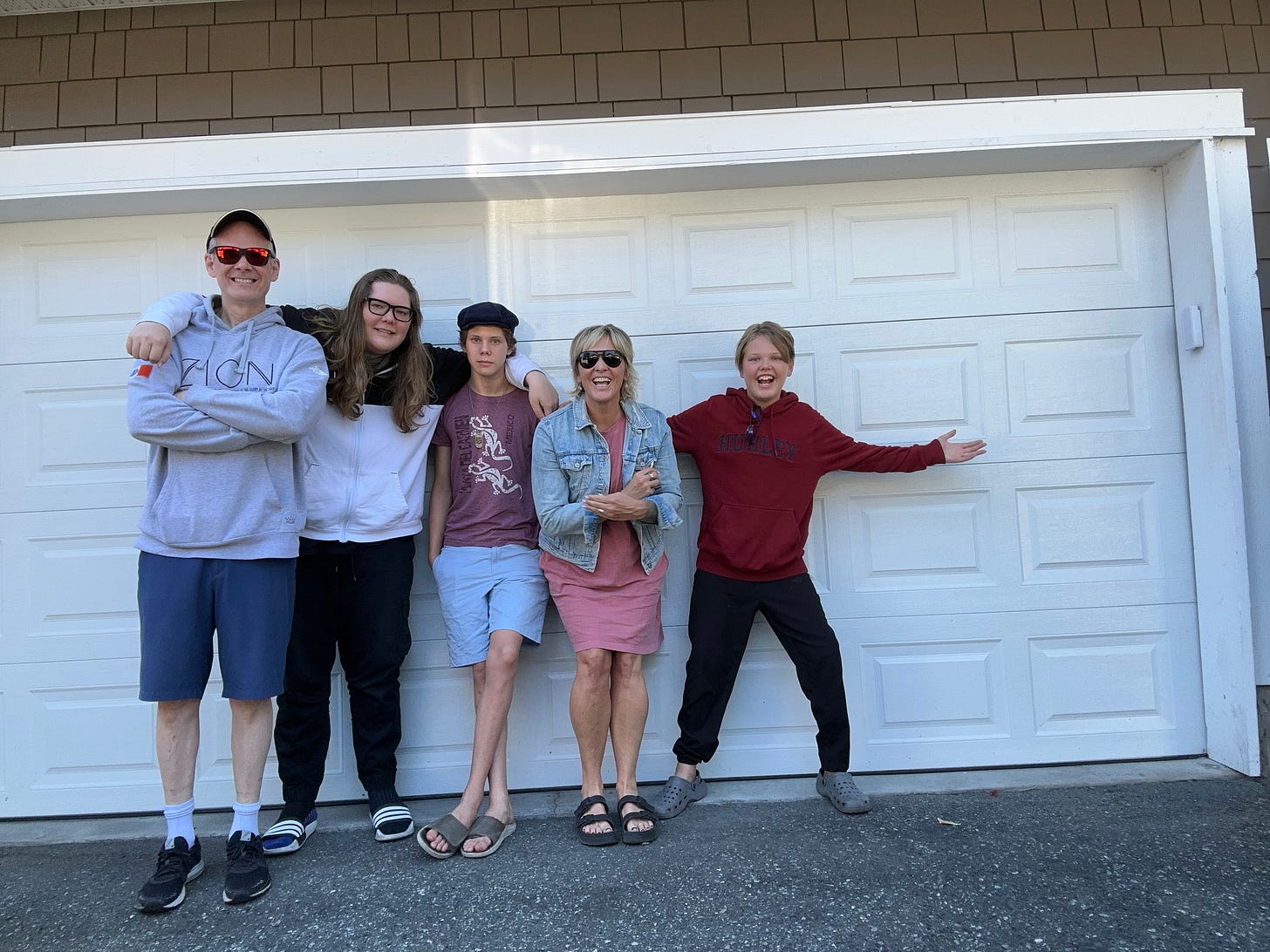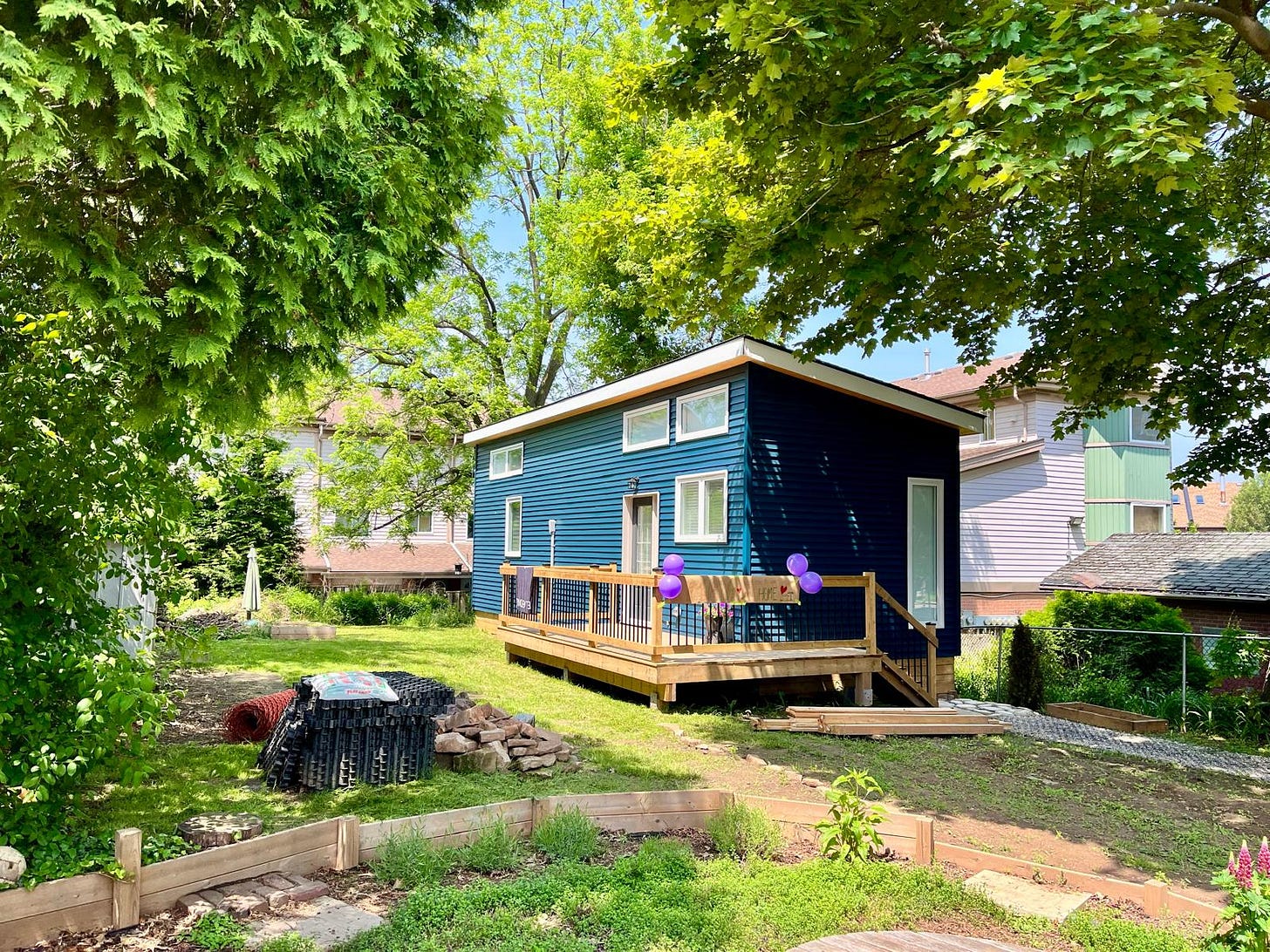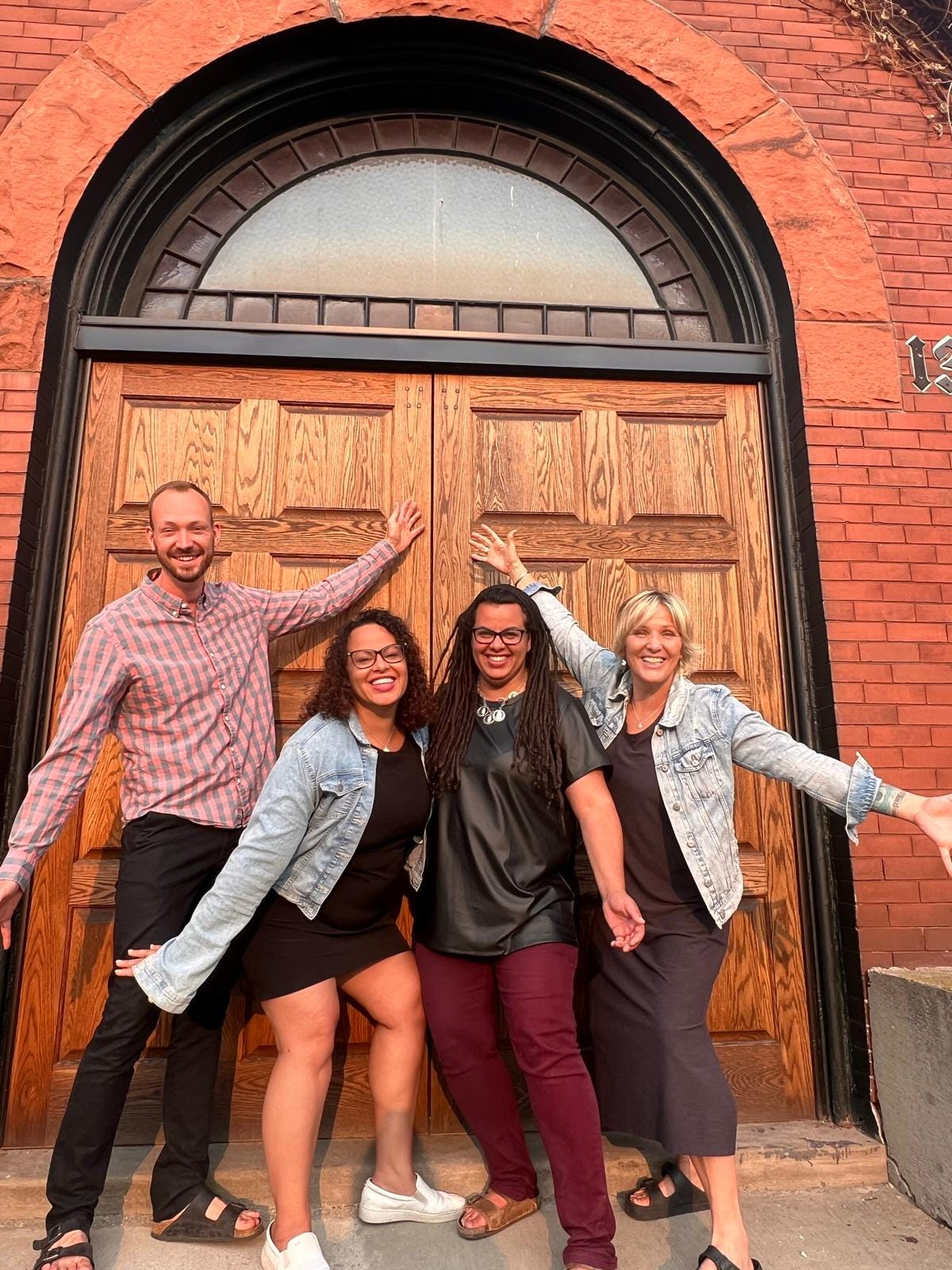I’ve lived in over a dozen different ‘homes’ in my years on this earth.
Our family arriving at our latest home last year in Burnaby, British Columbia.
As a kid, I lived in places throughout Canada. From the west coast of Vancouver, British Columbia, to the eastern edge of Prince Edward Island. In my adult life home continued to change: from a room at the American Embassy in Moscow to one in residence at college, a sailboat on the Red Sea in Southern Israel, an attic apartment, a house in rural northwest Canada, a co-op apartment in the Downtown Eastside of Vancouver, a condo in the urban metropolis of Melbourne, Australia, a bungalow in northern (and cold) Alberta, a spacious, corner unit in the picturesque suburb of Torrence, California, a duplex in North Toronto, and most recently, a Strata townhouse in Burnaby. I get around.
When I think of home I don’t think of these apartments, houses or rooms. The pilgrimage style of my upbringing and vocational calling doesn’t lead me to consider home as a static place or even a ‘physical place’ at all. When I recall those ‘homes’ I listed above I never much think of the actual buildings or structure or furniture or style. What I remember most about every location is the people I shared it with. Home, to me, is people. People to whom I belong and who belong to me. Home is family and friends, fellow pilgrims and adventurers. Home is support, and welcome. Home is where I can be myself. Home is where I exhale and relax. Home is where I am wanted, needed, loved, known. Home is not material or style, it’s not a colour scheme or specific location on a map - it’s a place I’m fully known and fully loved.
That’s the real tragedy of not having a home - it’s not only the disconnect from place it is the disconnect from people.
Recently, social norms have moved from calling people ‘homeless’ to ‘houseless’ and this may help to explain why. Just because you lack a place to live doesn’t mean you lack a place to belong. But I think it’s important to pay attention to the reality that to be houseless can also mean to be homeless. And to have a place doesn’t mean you’ve found a home. To NOT have a place you are welcome, to relax, to be known and loved is an incredibly tragic and terrible loss. The implications of houselessness on people’s lives and wellbeing is horrific. Many of the houseless folks who suffer from Mental Illness, experienced an increase of affliction AFTER they were houseless.
The same is true for addiction, abuse and crime, the stats are alarming. The Canadian government’s social response to this is a policy called ‘housing first’. The idea is that because houselessness is such a causal factor of ongoing harm, prioritizing housing is a strategic solution. I agree that people need housing but I think missing the distinction between houseless and homeless might be a catastrophic error. And if we understood it more clearly it could help navigate a better way forward.
The real cost.
If we think houselessness has terrible implications (which it does), let’s just imagine the kind of trauma that homelessness inflicts. To be homeless means not having a people to belong to, a place to connect, or be welcomed as you are. It is an affliction to be unknown and conclude that you are unloved or wonder if you have any value. I’ve moved people who suffer this fate into new places to solve their houselessness. A few months later I ran into them on the same street they had left. “Why would you give up your new place to return to the streets?” I ask. They told me they’d never felt more lonely and couldn’t live in a place they weren’t welcome. A home is much more than a physical construct. Mother Teresa spent years serving the poorest of the poor in the slums of Calcutta and said that loneliness was the greatest poverty she had ever seen.
“The greatest disease in the West today is not TB or leprosy; it is being unwanted, unloved, and uncared for. We can cure physical diseases with medicine, but the only cure for loneliness, despair, and hopelessness is love. There are many in the world who are dying for a piece of bread but there are many more dying for a little love. The poverty in the West is a different kind of poverty -- it is not only a poverty of loneliness but also of spirituality. There's a hunger for love, as there is a hunger for God.” A Simple Path, Mother Teresa
Homelessness includes a lack of human connection and belonging that makes people suffer. When we feel unknown, and unloved and unwelcome - that’s when the trauma of houselessness turns to homelessness and moves to a deep, soul illness. It’s a social sickness of the heart. It’s manifested in disconnection, fueled by scarcity and evidenced in tent cities across North American.
People are houseless because of greed and social constructs that place profit over people, but they are homeless because we have forgotten we belong to each other.
I’ve tried to combat houselessness because I know it’s a root cause of so many other social challenges. Preventing it could save many people from compounding oppressions. In almost every case, whether it was sober houses, community living or high rise low-income apartment complexes, the biggest threat to their actualization was not the city bylaws (although faster processes would be so helpful), it wasn’t the government (they are aware of the need for housing), it isn’t even the funding (although we could really use some money!). The biggest threat to the development of building homes were the neighbours who didn’t want them. When a permit is requested for housing solutions in neighborhoods I’ve lived, it often receives a response from people in that community with signs and attitudes, ‘NOT IN MY BACKYARD’!
This sentiment is fuelled by ignorance and prejudice. It’s a posture that’s defensive and small. It views housing as territorial and exclusive. It separates and isolates us from each other. It suggests that those who suffer from poverty are inferior and a threat. It negates the power of hospitable living. It misses the opportunity and invitation difference provides. It’s dated and based on ideology that fosters exclusivity and autonomy, putting neighborhood ‘home value’ (profit) over belonging and community. It is the same fuel that has spread the nightmare of ‘housing as financial investment’ over homes people live in and continues to trap people in unaffordable living cycles, creating even more need for affordable housing.
So, what to do?
I’ve tried a few strategies over the years. I’ve stood against city ordinances, tried to reason with the ‘Not In My Backyard’ folks, I’ve protested the lack of prioritizing/building affordable homes and tried to educate people around the power of belonging and the invitation difference offers us to grow. I’ve worked on grassroots community development projects, created places for intentional connection and tried to live my own life as an example of how beautiful it is to make room for others. I think those things have mattered. But they aren’t enough. We need a massive shift in our rooted beliefs around what home is and how we live differently together.
The homeless crisis is not just about houses, it’s about our disconnection from each other. One of the greatest threats facing our western social framework is loneliness. They are calling it an epidemic. Experts say it’s as dangerous as smoking 50 cigarettes a day. The cost of investment real estate and autonomous, individual and exclusive living is paid not just by those who can’t afford houses but by a deep disconnection that causes suffering for everyone, including those who have homes!!
The move in party for our first Imby home. 2024
What if we reimagine home as a place of belonging that created interdependence, healthy mutuality, shared spaces, and dignity for everyone?
What if we called this last era of western suburban exclusive based living and investment real estate a social experiment that has failed us? What if we began to rediscover that connection is better than individualism and that to be truly happy means to belong in meaningful ways with others?
This is the dream of IMBY (In My Backyard). It was created as an alternative to exclusion. It provokes two major ideas that might just help us scale the possibilities of making room for everyone:
We can do something.
The power of change is always at the grassroots level. One of the greatest tragedies of this season is the lie that has deeply imbedded itself in our collective psyche that we can’t change anything. Creating belonging and inclusion is NOT just a government project. We don’t have to shake our heads at the sprawling tent communities in our cities as the crisis of homelessness grows. We have capacity. Agency. We have power and privilege. We can decide to live differently, starting right where we are. We really can be the change we wish to see in the world.
There is enough for everyone.
The suburban ideals of exclusivity and sprawling spaces for the nuclear family is over. it’s failed us. So, it’s time to change. It’s time to open our gated communities, our fenced in backyards and create space for others. It’s time to reevaluate how we want to live and be part of recreating a better future for everyone. The idea that there isn’t space for people is a lie. We make space.
Maybe you’ve heard of the incredulous unbeliever who asked a nun how she could believe in a God who allowed abject poverty and she replied, ‘don’t go blaming poverty on God. Terrible poverty exists simply because God’s children refuse to share.’ This can be considered an oversimplified answer to a complex problem, but I’ve always had a hunch that we overcomplicate what we don’t want to do. What if the solution to our housing crisis was as simple as sharing what we already have? What if we started with our own backyards?
How it works.
So far, the model pilots for IMBY (In My Backyard) have been people with homes and capital, building additional dwelling units in their backyards. These units range from studio, one bedroom and two bedroom. They are stand alone, or built on existing garages or extensions to houses. Each one has been a labour of love, albeit frustratingly slow as we navigate the various bylaws of each city. BUT, as we pilot the models we are celebrating that they are working. They are cost effective. They are not cheap (a quarter the cost of building a new house). But as a long term investment they offer a deeply rooted solution to the current crisis, and a better way to live for the long term. They are WAY cheaper than shelters and emergency responses to houselessness and the IMBY model has built in community support, creates healthy and sustainable change, and addresses two major issues of our times (housing and community).
Consider this:
It costs 80,000 dollars (on average) to house one person in a shelter in Ontario for 1 year. IMBY communities make a ten year community contract. The cost of building an IMBY home is 150,000 (on average, without the saved costs of scaling production). So for less than the cost of 2 years in a shelter, which offers no long-term solutions, little to no community support and doesn’t even calculate the additional costs of emergency services, crisis management or additional compounding factors (addiction, mental health and police services). IMBY can save cities 640,000 per person housed and countless more through the proactive strategies of supportive belonging and inclusion in communities. Right now the IMBY model includes the dweller paying a 30% income rent. Even with a reduced rate the rent will most likely cover the expenses of the build in 10 years. And the property owner sees an increase in their property value. Is it possible that everyone can win? Can we even imagine creative housing solutions that are deep and true and wise?
We can. And we are excited and amazed to see others catching the vision! We dream about reducing the barriers to creating more of these IMBY communities across the western world. Wanna help?
Here’s what would really help.
Speedy processes: A fast track approval process that takes the architectural models (already inspected and approved) and bypasses the time/money that holds up our timelines and adds extra and unnecessary expenses to each individual projects.
Funding: Large scale funding that could scale the production (there are faster and more productive ways to create these units) and pay our volunteer team to do this full time! This would expedite the impact and respond to the desperate needs of communities across North America.
Sacred partners: Partnering with churches to transform their backyards/land and create Sacred Settlements (our partners in the USA are leading the charge in this space - www.sacredsettlements.org). Church land could host IMBY communities (several tiny houses with shared communal spaces in the church), re-thinking what it means to have sacred space that would represent God, model radical inclusion and display the Good News of Jesus. We have a church community right now in Ontario already hard at work creating this display of God’s splendour!
Mobilization: Hundreds of homeowners with backyards and capital, and dozens of builders and contractors who are willing to devote themselves, mobilize, and create the change we need in making our lives better together. We see IMBY communities in every town and city across North America, composed of hundreds of IMBY builds offering a new vision for what it means to be flourishing and connected.
What is a home? I think IMBY offers a vision for housing but even more essential, it offers a beautiful vision of a home more spacious than we have ever imagined.
Wanna help live the dream?
Bette Dickinson Art piece for IMBY called ‘home’. Bette presented this to Maya in the first Imby home.
We are a vulnerable team, daring greatly. Join us.
Timo and Siobhan Koch, Alicia Wilson and Danielle Strickland are the Imby Team.
We’ve just released the IMBY building blocks training course at the deep and wide academy. You can take it with some friends who are trying to reimagine with you, Or sign up for a guided version where you meet with a coach from IMBY to walk you through the basic recipe for unlocking your imaginations and getting to work in your local context.
Sign up with your community or household to take the Imby course. Learn the building blocks of beginning to live differently and start to imagine it in your own area.
Volunteer. We are looking for social media creators, administrative help, accountants and financial expertise, lawyers with land contract experience, networking overseers for online training and connections, business people, builders etc..
Join our online networking community IMBYCO to share the word about your interest and connect with others around your area. Or better yet - volunteer to help us manage that network!! :-)
Consider giving to IMBY (we are a charity). Or spread the news of our funding needs to potential funding partners.
This is a long post and at the same time - it isn’t long enough! Thanks for reading it - it’s an important part of my own journey and my dreams for a future that demonstrates just how wide and high and long and deep is the Love of God. I pray Love will lead us all to build a better world. There is so much space friends.
source articles:
https://www.phs.ca/vancouver-study-homelessness-is-a-medical-emergency/
https://www.caringworksinc.org/our-impact/community-impact/#:~:text=Homelessness%20Affects%20All%20of%20Us&text=It%20has%20a%20ripple%20effect,as%20well%20as%20the%20future.
https://housing-infrastructure.canada.ca/homelessness-sans-abri/resources-ressources/housing-first-logement-abord-eng.html#






